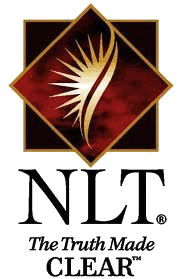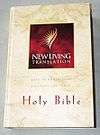New Living Translation
| New Living Translation | |
|---|---|
 | |
| Full name | New Living Translation |
| Abbreviation | NLT, NLTse |
| Complete Bible published | 1996 |
| Textual basis | Revision to the Living Bible paraphrase. NT: Greek New Testament (UBS 4th revised edition) and Nestle-Aland Novum Testamentum Graece 27th edition. OT: Biblia Hebraica Stuttgartensia, with some Septuagint influence. |
| Translation type | Formal and Dynamic equivalence[1] |
| Reading level | Middle School |
| Copyright | Copyright 1996, 2004, 2015 by Tyndale House Foundation[2] |
|
In the beginning God created the heavens and the earth. The earth was formless and empty, and darkness covered the deep waters. And the Spirit of God was hovering over the surface of the waters. Then God said, "Let there be light," and there was light. For God loved the world so much that he gave his one and only Son, so that everyone who believes in him will not perish but have eternal life. | |
The New Living Translation (NLT) is a translation of the Bible into modern English. Originally starting out as an effort to revise The Living Bible, the project evolved into a new English translation from Hebrew and Greek texts. Some stylistic influences of The Living Bible remained in the first edition (1996), but these are less evident in the second and third editions (2004, 2007). As of March 2014, the Christian Booksellers Association ranks the NLT as the second most popular English version of the Bible based on unit sales.[3]
Translation philosophy

The New Living Translation used translators from a variety of denominations. The method combined an attempt to translate the original texts simply and literally with a dynamic equivalence synergy approach used to convey the thoughts behind the text where a literal translation may have been difficult to understand or even misleading to modern readers. It has been suggested that this "thought-for-thought" methodology, while making the translation easier to understand, is less accurate than a literal (formal equivalence) method, and thus the New Living Translation may not be suitable for those wishing to undertake detailed study of the Bible.[4]
Textual basis
The Old Testament translation was based on the Masoretic Text (Biblia Hebraica Stuttgartensia) and was further compared to other sources such as the Dead Sea Scrolls, Septuagint, Greek manuscripts, Samaritan Pentateuch, Syriac Peshitta, and Latin Vulgate. The New Testament translation was based on the two standard editions of the Greek New Testament (the UBS 4th revised edition and the Nestle-Aland Novum Testamentum Graece 27th edition).
Translation history
Work on this revision began in 1989 with ninety translators and published in July 1996; 25 years after the publication of The Living Bible. Advanced reader copies of the book of Romans were originally printed as the New Living Version, but eventually renamed the New Living Translation to avoid confusion between this new work and The Living Bible. NLV is still used to identify the New Living Translation in ONIX for Books. Soon after that, a new revision was begun and The Second Edition of the NLT (also called the NLTse) was released in 2004.[5] A revision in 2007 comprised mostly minor textual or footnote changes.[6] Other revisions were released in 2013 and 2015 with minor changes throughout.
In 2016, Tyndale House Publishers, Conference of Catholic Bishops of India Commission for Bible, ATC Publishers Bengaluru, and twelve Biblical scholars collaborated to prepare a New Living Translation Catholic Edition.[7]
Translation properties
The New Living Translation is (according to its publisher) intended to be easily accessible to readers of modern English. As part of this effort:[8]
- Weights and measures, money, dates and times etc. are described in modern terms, with footnotes giving the literal translation, for example John 6:7 states
- "Philip replied, “Even if we worked for months, we wouldn’t have enough money to feed them"
with a note that the Greek text reads "Two hundred denarii would not be enough" and an explanation that a denarius was equivalent to a laborer’s full day’s wage.
- Some phrases are translated into contemporary English; e.g. "they beat their breasts" (Luke 23:48) is translated as "They went home in deep sorrow", again with footnotes providing more literal interpretations.
- Gender-inclusive language is used where the editors believed that it was appropriate, thus ἀδελφοί (adelphoi) is translated "brothers and sisters".
Circulation
In July 2008, the NLT gained the No. 1 spot in unit sales, unseating the NIV for the first time in over two decades.[9] According to the Christian Booksellers Association (as of March 2014), the NLT is the second most popular Bible translation based on unit sales, and the fourth most popular based on sales numbers.[3]
A Roman Catholic edition of the NLT with the Deuterocanon has been published by ATC Publications in Bangalore, India. The NLT Catholic Edition (NLTCE) has been granted an imprimatur by Oswald Cardinal Gracias, Archbishop of Bombay and President of the Council of Catholic Bishops of India.[10] The imprimatur does not extend to use of the NLTCE in the liturgy, but it has been officially approved by the Roman Catholic Church for private study.[11]
The NLT is available in numerous editions as well as numerous study Bible editions, including: The Life Application Study Bible, The Discover God Study Bible, The NLT Study Bible, and the NLT Illustrated Study Bible. The Cornerstone Biblical Commentary series uses the second edition NLT text as its base.
References
- ↑ "NLT FAQs". Tyndale House Publishers. Retrieved 2015-03-01.
- ↑ Copyright notice on BibleGateway Retrieved 14 August 2016
- 1 2 Bible Translations (March 2014 Bestsellers)
- ↑ Rhodes, Ron (2009). The Complete Guide to Bible Translations: How They Were Developed. Harvest House Publishers. p. 152. ISBN 978-0-7369-2546-4. Retrieved 30 September 2010.
- ↑ "New Living Translation™: Discover The NLT - FAQs". Retrieved 10 May 2016.
- ↑ "NLT Blog". Retrieved 10 May 2016.
- ↑ cbf-admin. "Launch of the New Living Translation Catholic Edition". Catholic Biblical Federation. Retrieved 10 May 2016.
- ↑ "Introduction to the New Living Translation". Retrieved 30 September 2010.
- ↑ "NLT #1 on July CBA Bestseller List", New Living Translation Blog
- ↑ "Bengaluru: Apostolic Nuncio releases 'New Living Translation - Catholic Edition' Bible". Retrieved 10 May 2016.
- ↑ See the copyright page of any copy of the NLTCE.
